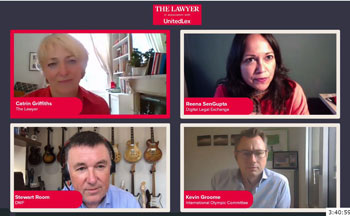
Keeping close to the customer is the key to a successful enterprise-wide subscriptions strategy, says Andy Baker. And he should know. Not just as he has led teams that have transitioned two leading business-to-business brands from advertising-dependent to subscriptions-led, but because the latest of those titles to transition – The Lawyer – recently won the PPA’s 2020 Business Information Product of the Year award.
The Lawyer was launched by Centaur Media as a weekly magazine for commercial lawyers, barristers and in-house counsel back in 1987. A decade later, it launched online, though it didn’t introduce a paywall – behind which around 95% of its digital content now sits – until 2016.
The year it went monthly, 2017, it was the PPA’s Business Media Brand of the Year. A few months after, Baker joined to drive through its transition to a subscriptions-led model from Ascential, where he had steered the same journey for Health Service Journal.
Today, with its focus on forward-looking data-rich content targeting the leadership teams of top legal service providers in the world’s leading international law markets operating out of London, The Lawyer is a leading provider of digital intelligence on the business of law.

According to the publishers, thelawyer.com has 264,400 unique registered users with 5,000+ partner and general counsel-level subscribers visiting monthly. And its print offering has a circulation of 6,000 copies read by 18,000+ senior lawyers each month.
The Lawyer is also a highly-respected brand – the media brand its readers most read in addition to it is the Financial Times. All of this played an important role in its transition from ad-driven to enterprise subscriptions-led – a transition which took three or four years.
“In 2015, paid content was about 15% of The Lawyer’s revenue,” says Baker, managing director of The Lawyer.
The title had sold its benchmarking market reports for quite some time and the balance of its revenue came from recruitment, marketing solutions and events.
“But by 2019, paid content was 41% of revenue – and at that time, The Lawyer saw its best revenue and profit growth in six years,” he explains. “The transformation of the P&L to being led by paid content has been a fundamental change in our business model and mindset.”
The journey began in earnest after Baker’s arrival and focused on two fronts: transforming the digital product, and transforming skills and thinking.

In 2018, thelawyer.com was relaunched – providing a firm foundation for a new enterprise-wide subscriptions business involving selling each law firm a single, organisation-wide subscription for multiple user access.
Attention then switched to launching new data-driven subscription products outside thelawyer.com – such as the Litigation Tracker, in January 2019. It also took its benchmarking product online. Then in January 2020, it launched Horizon by The Lawyer – a daily newsletter that goes out at 7am with all of its information contained in it, so users don’t need to click through to thelawyer.com website.
“The idea was that Horizon content would be short and succinct and data-led, and we hired more journalist resources to do that – including our first data journalist,” says Baker.
The transformation of the P&L to being led by paid content has been a fundamental change in our business model and mindset.
Habit forming
“This was because clients were increasingly telling us that opinions are one thing and often valued, but what they want was to see the evidence behind opinion, too. We now have over half of our subscribers on a daily or a weekly digital habit with us, and this is a big plus.”
Most people regularly use only three of four preferred sites professionally, and they are used to the way those sites are structured and rate that content highly. So, it is hard to get onto that roster but being on it delivers a powerful competitive advantage.
“If we get people into a digital habit with us, they are less likely to go elsewhere,” he continues. “And we are deepening that relationship daily – but only as long as we live up to the high bar we set ourselves with content. Get this right and it becomes easier to introduce even more services.”
Today, he says, 300+ organisations have enterprise-wide subscriptions with The Lawyer, and among these are 90% of the top 50 UK and top 50 US firms operating out of London.
Securing these has not just been about great content, however. As important has been building a compelling value proposition for each subscriber. And that’s been as much about changing the team’s mindset.
“A subscriptions business mindset has a number of differences from an advertising or event mindset,” Baker explains. “One is regarding renewals as the true worth of subscriptions; it’s where you really have to focus. So, you have to think of clients, even more than in advertising and events.”
If we get people into a digital habit with us, they are less likely to go elsewhere.
Customer insight
This means making sure you have great onboarding skills. Another aspect of mindset unique to subscriptions is an obsession with customer discovery, however, because close and sustained contact with each enterprise subscriber is needed to get the proof of where customers have found content valuable that is then used to ensure subscriptions are renewed.
“We regularly ask questions such as how our content is used, which content a customer would miss most if it wasn’t there, what problems in their business they would spend £50k on, and so on,” Baker says.
Such questions ascertain customer success – what clients gain from your content, which is useful in two ways.
First, to help the person procuring the subscription – who, in a law firm, is unlikely to be the actual reader – justify the investment to his or her stakeholders. Second, to identify where your data might be useful, which provides an important foundation for new product development.
“All of our salespeople undertake aspects of customer success. Their job is to continually question and feedback. That’s our business as usual,” he adds.
Be bold about content pricing as it’s an uphill climb from a too low price point.
Account based selling
A switch to account-selling has also been important. “Before, we had different salespeople pitching different information products to the same law firm, but I think that leads to confusion with the client,” Baker continues.
“Now, we have one salesperson handling all of our information products for one law firm. This means that salesperson can build a deeper client relationship, understanding the client better and navigating around the law firm in a more meaningful and productive way.”
New approaches to evaluation have also been developed.
“We spent some time making sure we got the right metrics for volume renewal and account uplift and put the two together to get the value renewal rate – you can’t run a subscription business without that,” he adds.
“We pay particular attention to the number of subscribers that visit, frequency of visits and the number of articles they consume. We spent quite a lot of time getting our usage analytics in great shape, and sharing and communicating what that data means.”
Engagement analytics, Baker stresses, is a critical tool for successful subscriptions.

New product development skills have evolved, too.
“We now start with our digital product people and with our clients – sometimes using outside research help, and the process begins with very open questions, such as: where is the pain in your business?” he says.
“Once we’ve gathered enough of that and think we have an idea that might solve some of this customer pain, we say to a client: we have this idea, it looks like the following, what do you think?”
So, key skills now needed are around articulating what the product promise is. This is important for everyone internally, so all have a common vision of the product and can articulate simply to the client and (hopefully) they say ‘yes’, this is something they can buy into. Client input is then sought again once an idea goes into development, for example to get their input on key features.
Engagement analytics is a critical tool for successful subscriptions.
Lessons learnt
Pricing is another important skill – and an area where, Baker admits, the team has learnt an important lesson.
“One of our biggest challenges has been yield. Like many publishers, when we introduced our paywall, we were uncertain how to price and, at first, our prices didn’t reflect the value of our content,” he reveals.
“Over time, we have had to go back to users where usage is especially high but money spent per user is particularly low to present them with detailed information about our value to them, to discuss how we can work together to ensure over time they pay more.”
Next priorities are to continue developing the product and diving deeper into emerging customer segments, such as specialist law firms being set up or accounting firms’ new legal divisions.
Looking back, Baker identifies three key lessons for any publisher now considering making a similar advertising to enterprise subscriptions journey.
First, be bold about content pricing as it’s an uphill climb from a too low price point. To price boldly, he advises, make a clear case for the value you can provide – especially in terms of how your content can help a customer better meet their business objectives and address related problems.
And to make a clear case, invest in gathering the best customer insight.
Second, you can never do enough customer discovery work. (Why is outlined in Lesson One).
Don’t allow the day to day running of your business let it slip down your list of priorities, he says. Staying close to the customer is genuinely the best – if not, the only – way to run and grow an effective subscriptions business, whether growth will come from yield or developing new products.
Finally, when launching new products, have open conversations with your customers every step along the way. This should begin with identifying the right concept: those products that will best serve your customers’ most pressing needs. It should continue with honing the product promise.
Then, once you start building the new product, return to the customer again – ideally, he says, so their input directly feeds into the building process.
Staying close to the customer is genuinely the best – if not, the only – way to run and grow an effective subscriptions business.
This article was first published in InPublishing magazine. If you would like to be added to the free mailing list, please register here.












